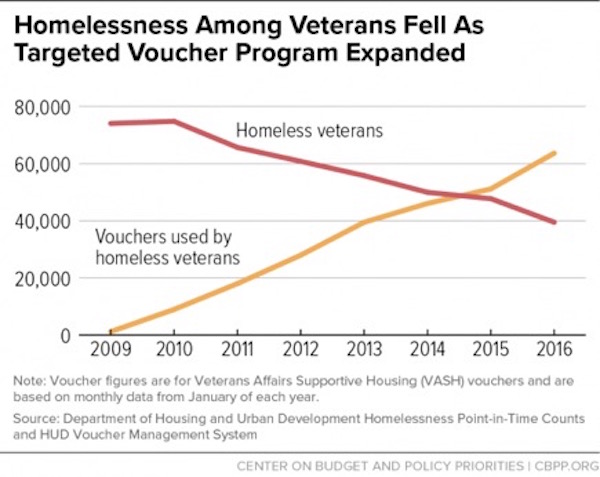Housing, Health, and Tax Programs Help Veterans
Veterans’ Day is an appropriate time to highlight programs that help many low-income veterans and military families make ends meet and consider how these programs can be improved. Policymakers’ actions in areas such as housing assistance, health coverage, and tax credits for working families affect thousands of veterans and their families in every state.
Since 2010, the number of homeless veterans has dropped by 47 percent. One key to this progress is the Housing Choice Vouchers program, which has aided tens of thousands of homeless veterans. Policymakers have funded these targeted vouchers since 2008 through the Department of Housing and Urban Development-Veterans Affairs Supportive Housing (HUD-VASH) program.
HUD-VASH pairs housing vouchers with supportive services — including mental health and other health care — administered by the Department of Veterans Affairs (VA). As the following graph shows, HUD-VASH has helped spur the rapid decline in veteran homelessness.

In addition to expanding HUD-VASH, policymakers have boosted VA funding for short-term homelessness-related assistance, and communities have targeted other housing resources on homeless veterans to help more of them get stable housing.
The success of HUD-VASH shows that targeted federal resources can drive down homelessness. Policymakers could do the same for other groups, such as families with children, by making a new commitment of Housing Choice Vouchers and other resources.
The HUD appropriations bill proposes $20 million for 2,500 new vouchers in 2017 for families and youth who lack stable housing and are involved in the foster care system. And President Obama’s 2017 budget includes 10,000 new vouchers for homeless families with children. Congress should include both proposals in the final HUD funding bill for 2017.
Significant numbers of veterans have recently gained health coverage, too, since the Affordable Care Act’s major coverage provisions took effect. Their uninsured rate dropped from 11.9 percent in 2013 to 6.8 percent in 2015, with the biggest gains coming in states that adopted the Medicaid expansion. In addition, the share of veterans reporting an unmet health need due to cost fell from 7.3 to 4.5 percent between 2013 and 2015, and the share reporting trouble paying medical bills fell from 16.3 to 14.9 percent.
States can do more to improve veterans’ health coverage. The Urban Institute projects that some 604,000 veterans will be uninsured in 2017. Most of the veterans without coverage are in the 19 states that haven’t yet expanded Medicaid. In non-expansion states, 39 percent of uninsured veterans qualify for Medicaid or health-care tax credits. By contrast, 70 percent of uninsured veterans in expansion states qualify.
Many uninsured veterans in non-expansion states are caught in a “coverage gap,” meaning incomes are too high for Medicaid but too low for marketplace tax credits. In North Carolina, for example, 49 percent of uninsured veterans fall into the coverage gap and would become eligible for Medicaid if their state expanded. In Florida and Georgia, 44 percent of uninsured veterans would become eligible for Medicaid if their state expanded; in Texas, 33 percent would.
Most veterans get health coverage through their employer, but for those without access to job-based coverage, large gaps exist. While some veterans receive coverage through the VA health system, some don’t qualify, don’t live near a VA facility, or aren’t aware of VA care. Coverage expansions have helped plug these gaps, but further health-coverage gains will depend largely on whether more states expand Medicaid.
Finally, the Earned Income Tax Credit (EITC) and the Child Tax Credit (CTC) — pro-work tax credits for low- and moderate-income working households — boost the economic security of millions of veteran and military households. Roughly 2 million veteran and military households earn the EITC, the low-income component of the CTC, or both.
The federal EITC and CTC together keep roughly 140,000 veteran and military households from falling below the poverty line and lessen the severity of poverty for another 420,000 such families. But workers who aren’t raising children in the home are eligible for little or no EITC — they’re the only group that the federal tax code actually taxes into poverty. Policymakers could strengthen the EITC for more than 600,000 veterans and active duty service members by expanding the credit for this group.
Jacob Kaufman-Waldron is a Communications Associate at the Center on Budget and Policy Priorities.




